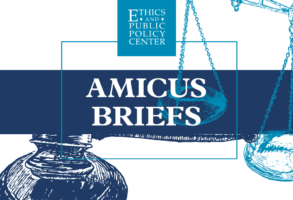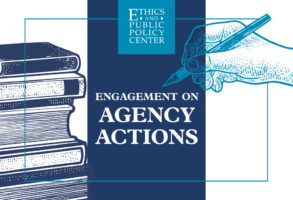
Published November, 2023
George Hawley’s insightful article, “The Myth of Republican Radicalism,” will probably surprise many readers, but not me. His research confirms what most research has shown over the past few years: the Republican voters’ attitudes on a host of contentious topics remains roughly what it was before Donald Trump’s 2015 ride down the escalator. The real question should be why so many people think otherwise.
This confusion is not just a Democratic phenomenon. Republican elites and many officeholders remain starkly out of touch with their own voters. They were shocked in 2016 to see someone seize the GOP nomination who was out of step with party orthodoxy on matters like entitlement cuts, trade, and opposition to endless foreign wars. Today, they remain in disbelief that the party they thought they understood is actually a coalition of groups that strongly disagree with one another on core issues.
Trying to answer this requires some guesswork rather than a deep dive into data. I can offer only two reasons, however, for the fundamental misperceptions that elites, left and right, have about the GOP coalition.
The first is a simple lack of familiarity with average voters as opposed to the most visible elements, both elite and common. The second is a singularly intense animosity toward those who hold different views than theirs, which leads to discounting the evidence no matter how much is presented to them.
If one listened to GOP and conservative leaders in 2015, one would have thought the Republican party was co-extensive with the conservative movement. Voters were assumed to be uniformly in favor of tax cuts, entitlement cuts, abortion restrictions, and intervention throughout the globe in favor of democracy protection. Virtually no national officeholder disagreed with these views; every major GOP-friendly think tank echoed these beliefs; and the activists who people major grassroots meeting shouted them from the rooftops.
But the evidence was clear these were never universally-held positions. The Pew Research Center’s 2014 voter typology clearly showed that large majorities of Republican voters were OK with candidates who raised taxes and were pro-choice on abortion. Large majorities were also opposed to cutting future Social Security benefits. And there were sharp disagreements over whether free trade was a net benefit to America and whether the U.S. should concentrate on problems at home or continue to be involved extensively in global affairs.
In short, Trump reflected and gave voice to pre-existing views rather than imposi them on his party by dint of personality.
Fast forward to today and one sees little change in establishment thinking. Most of the pundits one sees on television believe the Republican voter is in thrall to Trump for personal and irrational reasons rather than due to a profound disagreements with the pre-Trump Republican leadership. The presidential candidacies of Nikki Haley and Tim Scott are predicated on this view. Mike Pence specifically rejected the idea that what he called “populism” had any place in the GOP, before he dropped out of the race in October. These candidates simply refuse to see what the Republican coalition wants, and instead seek to re-establish the pre-Trump orthodoxy that effectively ignored large elements of the Republican base.
Democratic pundits make an identical mistake for opposite reasons. They have always thought the Republican Party was really composed of racists and “deplorables”. Trump’s rise and his bombastic rhetoric simply confirmed their prior beliefs. The fact that large majorities of Republicans disagreed with Trump on many of his core principles was simply ignored because it did not fit the narrative.
Immigration is a key example. Exit polls showed that even in the 2016 GOP primaries, only two states had a majority who favored deporting illegal immigrants rather than giving them a path to citizenship. Emily Ekins’ analysis of the 2016 vote also showed Trump’s appeal extended well beyond appeals to race and ethnic prejudice. Ekins found that five distinct groups of voters backed him over Hillary Clinton, and that they had wildly divergent views on matters of race and identity. Most Trump voters, for example, did not believe that being white was important to their personal identity. A super majority believed that being accepting of people from diverse racial and religious backgrounds is essential to American identity. Yet the canard persists that Republicans are primarily motivated by racial animus.
More recent data show that the GOP is still divided on these and other core issues. The New York Times finds six groups of Republican voters, some them hard-right conservatives, others socially liberal or moderate. Despite this complexity, mainstream analysis continues to peddle the idea that Republicans are an intolerant monolith.
These observations lead ineluctably to the second point. Democratic and Republican elites disagree on much, but they both have reasons to despise Trump voters and hence both overemphasize their power and mischaracterize their views.
Democratic elites tend to be very progressive on economics and culture, as analyst Ruy Teixeira frequently points out. They want to rapidly transform America rather than reform it, and thus view Republicans and especially Trump voters as evil resisters who must be exiled. Depicting the GOP as in thrall to this caricature of conservatism helps force otherwise moderate Democrats and independents to reluctantly back a progressive-led Democratic party. Making the GOP out to be evil and extreme gives them power they would otherwise struggle to obtain.
The same misunderstanding also allows Democrats to obscure the very real changes that have happened in their own party. Gallup’s poll shows that the share of Republicans who say they are conservative has barely changed since 2011, but the share of Democrats who say they are liberal has risen significantly. Liberals are now a majority of Democrats, and 2020 primary exit polls showed they are a significant majority among Democratic primary voters.
Republican elites hate the way Trump rallied pre-existing economic moderates into action. They want a return to the day when they didn’t have to worry about blue-collar job loss or the decline of America’s manufacturing base. They want to pass more tax cuts and put cultural issues aside. Understanding and accommodating their voters’ preferences would put those dreams on the back burner instead. Ronald Reagan observed decades ago that “human nature resists change, and goes over backward to avoid radical change”. GOP elites have bent over backwards so much that they now resemble pretzels in their unwillingness to acknowledge that the GOP voter always was less doctrinaire than they supposed.
Today’s conservative coalition is not much different than it was ten years ago. A responsible politics would recognize that and work to build a new fusionism that brings these elements together rather than set them against one another. That, not demonization and mischaracterization, ought to be the true North Star of today’s right.
Henry Olsen, a senior fellow at the Ethics and Public Policy Center, studies and provides commentary on American politics. His work focuses on how America’s political order is being upended by populist challenges, from the left and the right. He also studies populism’s impact in other democracies in the developed world.











